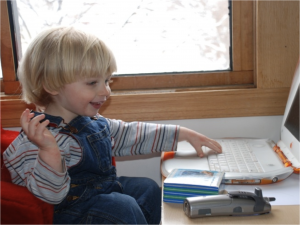Play is how we learn
Play as precursor to comprehension
The process of pretense in play can be very powerful, and it may be the factory of our analogical mind. Vygotsky claimed that it is play that begins to offer liberation from constraint– that we dissociate from teh “real world” into the imaginary world of our play.
In a review of studies by Lewin, it was posited that things dictate to a child what they must do: that we are shaped by tools, rules, relations, context and language; it may be situational constraint that creates direction and action based upon motives and perception; and these can be created through environment.
“but in play, things lose their determining force†and the child may understand the constraints of a condition but gain the ability to act independently of what they see—creating new choices. The act of creating the imaginary and otherness may be an early example of creating mental models of the world that will later be used for inference and reasoning in hypothesis testing—decontextualization and abstraction, allowing not only perception of the context, but perception of the situation and the relevance of that situation in a larger context, creating useful action with the act of perception, and also the act of making meaning.
 This is such a reversal of the child’s relation to the real, immediate concrete
This is such a reversal of the child’s relation to the real, immediate concrete
situation that it is hard to underestimate the full significance. The child does
not do this all at once because it is terribly difficult for a child to sever a kids-play-as-doctor
thought (the meaning of a word) from an object. . . Play provides a transitional
stage in this direction whenever an object (for example a stick) becomes a
pivot for severing meaning of horse from a real horse. The child cannot yet
detach thought from object. (Vygotsky, 1976, p 97).
Thus play seems essential to development, and the role of the pivot ( a toy, representation, or even a game) is important in aiding that early childhood development, where children may move from recognitive play to symbolic and imaginative play, i.e. the child may play with a phone the way it is supposed to be used to show they can use it (recognitive), and in symbolic or imaginative play, they may pretend a banana is the phone. This is an important step since representation and abstraction are essential in learning language, especially print and alphabetical systems for reading and other discourse. There are as many types of play as there are people and cultures. A few types to consider are:
• Recognitive, or Mastery play – learning how to use objects
• Creative play – playing with aesthetics
• Deep play – learning about risk and danger
• Recapitulative play – den building, hiding, climbing
• Dressing up – experimenting with identity
• Rough and tumble play – testing your own strength
For this reason play and gaming, structured forms of play, may be reasonable predictors for comprehension and problem solving. In play, we create models; try on roles; and experience the world in the safety of play. Play may also expand comprehension in surprising ways, but often activities involving play are seen as non-academic—therefore non-educational, lacking rigor and thus, not really learning (Dubbels, submitted).







Why is learning about danger and risk called “deep play”?
Hi Peter,
Deep Play comes from Jeremy Bentham’s analysis of play in the creation of law and the workings of government, and then explored in Geertz. The idea of Deep Play is not necessarily like transformative play where you go deeply into a state, but Deep Play, per the originators of the concept were looking at play in games that have consequences on entitlement and status — but not life threatening. In essence, they get close to real danger, but are not truly at risk– the stakes are not your life. I like Deep Play as being deep, meditative, flow, transformative activity, but it was already named and operationalized.
But transformative play builds upon the idea of flow and depth of experience rather than the risk and danger of higher stakes.